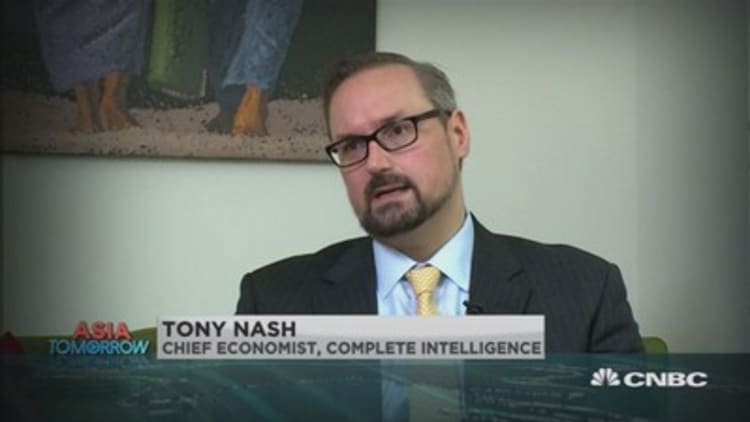The rupee has proven to be a dismal investment so far this decade, slumping 38 percent over the past 5 years and far underperforming the yuan's near 10 percent gain over the same period. But as India's economy fires up, the next five years are expected bring about a reversal of fortunes for the two currencies.
"There's more potential for the rupee to appreciate compared to over the next five years," Nizam Idris, head of currency and fixed-income strategy at Macquarie in Singapore told CNBC. "The main driver for the two currencies over the medium term will be the growth outlook, which drives capital flows," he said.
After years of lagging behind its biggest Asian neighbor, India is on track to overtake China as the world's fastest growing major economy this year. India's gross domestic product (GDP) is expected to pick up to 7.5 percent in 2015, before rising to 7.9 percent in 2016 and 8 percent in 2017, according to the World Bank. China's growth, by contrast, is forecast to moderate to 7.1 percent this year, 7.0 percent in 2016 and 6.9 percent in the year after. Last year, India's economy grew 7.3 percent, a touch below China's 7.4 percent expansion.
"Having said that, the rupee's outperformance is predicated on India's ability to anchor inflation," Idris noted, adding that China has had a better track record at doing so.

While Indian inflation has eased notably in the past year owing to lower global commodity prices, a tight monetary stance and government efforts to contain food inflation, it wasn't long ago that the country struggled with runaway prices.
"Global investors will need to trust that India will persevere with policies to keep inflation low while boosting growth," he said.
If Idris' assumptions are correct, he sees the rupee strengthening to 55 rupees against the U.S. dollar in 5 years, a 13.5 percent appreciation. He expects the Chinese currency to appreciate a meager 3 percent to 6 yuan against the greenback over the same time frame.
"The yuan will see less impetus for appreciation – growth is slowing which means that capital inflows will remain limited. On top of this, the government's push to boost consumption could cause the current account to deteriorate further," Idris said.
Read MoreMake in India: Lessons from China
China's current account surplus stood at $7.2 billion in the first quarter of the year, the smallest quarterly surplus in three years and much lower than the $44 billion recorded in the fourth quarter of last year.
Valuation check
Idris isn't alone in his call for the rupee to outperform the yuan in the medium term. Mitul Kotecha, head of FX strategy for Asia Pacific at Barclays, says on top of the growth argument, the rupee is a better bet from a valuation perspective too.
"It's a valuation and relative growth story," he said. As of March, the rupee was 12 percent undervalued while the yuan was 20 percent overvalued, according the according to the behavioral equilibrium exchange rate (BEER) model.
Not so fast
To be sure, not all agree that the rupee will have its time in the sun in the latter half of the decade. Khoon Goh, senior foreign exchange strategist at ANZ, believes the odds are stacked in the favor of the yuan given efforts by Beijing to liberalize its capital account.
"I think there's better potential for the yuan simply because the Chinese authorities are very focused on continuing to open up their capital account and making sure that foreign investors have easier access to onshore markets," Goh said.
Read MoreIndia 'the new China' for smartphone makers
Foreign ownership of Chinese government bonds stands at just 2 percent, presenting plenty of scope for inflows in the future, he said.
"In India, foreign institutional investor (FII) limits around Indian government bonds are close to exhaustion. The potential for further inflows really depends on whether policymakers increase limits," Goh said. "Those sorts of decisions happen on ad hoc basis in India – a contrast from China, where the policy path is very clear."
Goh sees the dollar-yuan at 6.15 and dollar-rupee at 65 in the next five years. Furthermore, he's not confident on India's ability to keep inflation in check over the medium-term.
"Typically, countries that run high inflation tend to see their currency depreciate over time to compensate for the loss of competitiveness resulting from high inflation rate," Goh said.





